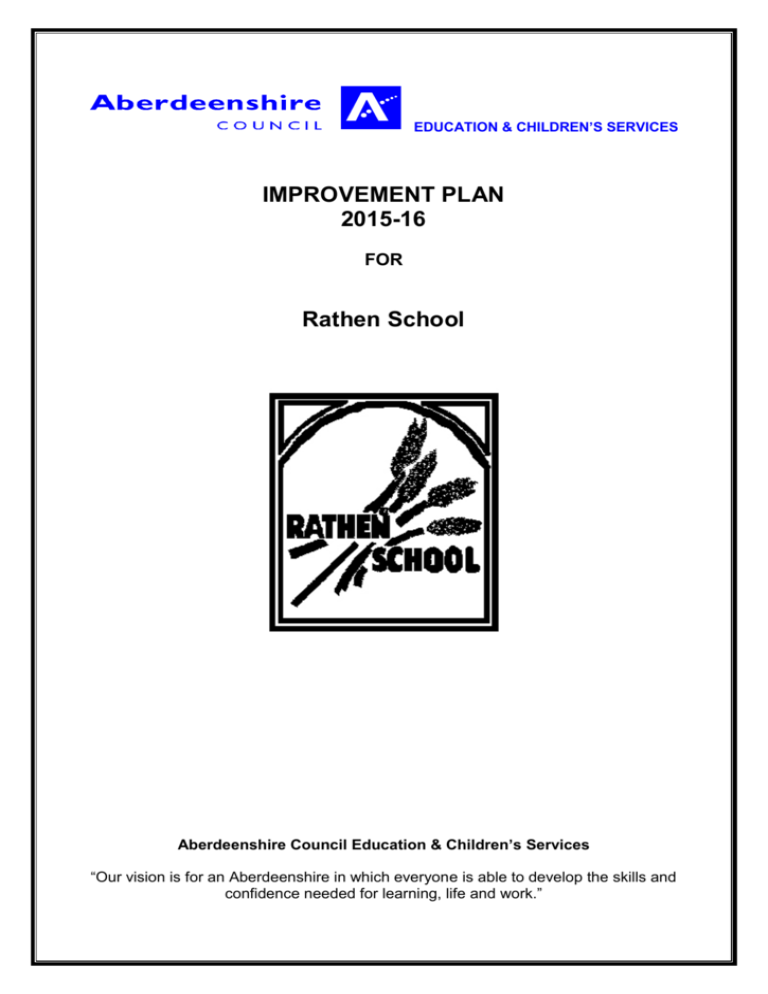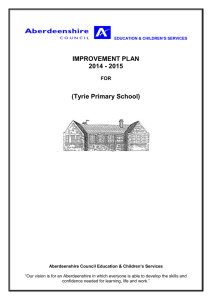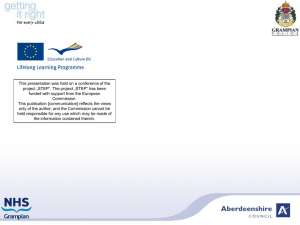Improvement Plan 2015
advertisement

EDUCATION & CHILDREN’S SERVICES IMPROVEMENT PLAN 2015-16 FOR Rathen School Aberdeenshire Council Education & Children’s Services “Our vision is for an Aberdeenshire in which everyone is able to develop the skills and confidence needed for learning, life and work.” RATHEN SCHOOL’S VISION At Rathen School, in partnership with parents and the school community, we aspire, through a caring approach to create an ethos which ensures everyone is valued and has a sense of belonging. Through high quality learning and teaching experiences, our vision is to nurture every child to reach their full potential, enabling them to have the skills and confidence to embrace the world as global citizens. In Rathen School our vision is the driving force behind all our improvement activity. Education & Children’s Service’s Quality Improvement Framework, is the overarching strategic management tool which directs and supports school improvement in establishments across Aberdeenshire. At the heart of the framework is the belief that self evaluation in each school drives improvement and all improvement is aimed at delivering positive outcomes for children and young people. “Self evaluation is a reflective, professional process through which schools get to know themselves well…Improvement Planning builds on that self knowledge by involving us in understanding and valuing the best of that which already exists, deciding how good we can really be, and identifying the best way forward. The Journey to Excellence Part 4: Planning for Excellence, HMIe, 2007 Self-evaluation is an on-going process and involves all stakeholders, including our pupils. It is reported annually to parents/carers in our Standards and Quality Report. Education & Children’s Service Improvement Cycle Self evaluation to find out where you have to go Review/ Re-affirm vision Identify priorities and specify outcomes Self evaluation to ensure stakeholders commitment Self evaluation to determine impact Check to ensure impact Take action Self evaluation to monitor and determine progress The priorities for improvement contained in the Improvement Plan for 2014 – 15 reflect this process and the priorities identified locally and nationally. Page 2 of 10 Improvement Plan Improvement Priority No. Intended Outcome (s) / Impact 1 CURRICULUM FOR EXCELLENCE Actions / Lead member of staff Timescales Page 3 of 10 Improvement Plan Active Literacy Raised attainment and achievement in language and literacy Cohesive and progressive active learnng teaching and learning approaches across all stages, with particular focus on reading. Build staff confidence in planning and assessing active learning in reading. Improved learning experiences for all young people. Increased motivation and enjoyment in relation to literacy and language. Six main reading strategies embedded to develop reading skills and build learners’ confidence. Active Literacy P5-7 teacher training session. (Mrs Geddes and Mrs MacGregor). Implementation of the Aberdeenshire Active Literacy Programme to develop the six main reading strategies. Inform parents of new approach and impact on homework. Monitor progress. Evaluate new approaches. P1-4 teacher training on Reflective Reading. (Miss Hay, Mrs Patterson and Miss Stephen) Audit current practice, plan, implement and evaluate new approaches. Curriculum Rationale and Design A clear and concise ‘Curriculum Rationale’ shared with all stakeholders. 3 year overview of bundles of Es and Os. Increased pupil involvement in the planning and evaluating processes. Curriculum Rationale and Design Stepping up Curriculum Rationale and Design training and documentation. (Mrs Geddes and Mrs Patterson) Review vision and values with stakeholders. Use the ‘Stepping Up’ tool to develop and agree on a Curriculum Rationale: Vision, Values, Curriculum Areas and Subjects, IDL, Ethos, Opportunities for personal achievement, Learning, Teaching and Assessment, and Transition. (Mrs Patterson) Bundle Es and Os by looking at the natural groupings within each curricular area across the levels and in cognisance of the Curriculum Rationale, bundling across the curriculum and over a 3 year programme with opportunities for discrete and interdisciplinary learning. (Mrs Geddes) Pupils involved in planning, assessing and evaluating the learning opportunities to achieve the outcomes: LI, SC, Assessment and Evaluation. Monitoring and Tracking Raise attainment and achievement by using a wide range of information to monitor and track learners’ progress and inform planning. Effective, manageable and sustainable monitoring and tracking processes implemented, providing valid, up-to-date information to support both learning and professional dialogue. Moderation activities and approaches used to ensure shared judgements are made regarding standards and expectations and, subsequently, increase staff confidence in their own professional judgments about learners’ progress. Term 4 2014/15 Feb Inset 2016 Term 1 and 2 Completed for all Es & Os by Term 4 Monitoring and Tracking Stepping Up Monitoring and Tracking training and documentation. Self Evaluation - Use the ‘Stepping Up’ tool and HIGIOUS 4 to identify where we are at, plan next steps and support staff development. Develop learners’ profiles, One Note: https://glowscotland.sharepoint.com/sites/3330021/Improving %20Learning/Aberdeenshire_Profiling/SitePages/Home.aspx QA calendar – scheduled moderation approaches. Page 4 of 10 Improvement Plan How will you measure success? Active Literacy -HT / SMT to monitor progress of implementation plan through Improvement Plan process. - Learning visits by HT SMT - Pupil sampling and learning conversations - Collegiate professional dialogue focussed on learning in language and literacy - Scrutiny of pupil attainment levels and assessment evidence - Planning for learning conversations between teachers and SMT - Ongoing professional discussion with staff with a focus on sharing of good practice - Ongoing self-evaluation and quality assurance processes - Feedback from Leadership for Learning Visits Curriculum Rationale and Design -Feedback from stakeholders on Curriculum Rationale. -Scrutiny of pupil attainment levels and assessment evidence. -Professional Dialogue – bundling, planning formats, learning and teaching experiences. -Tracking of coverage of Es & Os -Learner/teacher dialogue – impact of increased learner involvement, personalisation and choice on the learning experience and attainment. Monitoring and Tracking -Scrutiny of pupil attainment levels and assessment evidence. -Professional discussion - Evaluate planning, monitoring and reporting systems which should be fit-for-purpose, maximises the time spent on teaching and learning, support professional dialogue and avoid unnecessary workload. -Collegiate professional dialogue – shared judgements and expectations. -Pupil sampling and learning conversations to ensure effective learner dialogue is achieved through well-planned moderation approaches and activities. -Pupil sampling - Pupil profiles are valid and informative achieved through learner/teacher dialogue. Ensure learner/teacher partnership allows learners to reflect on their progress and develop the skills to support their own learning. Self-Evaluation -Use of HIGIOUS 4 in Self-Evaluation process. Progress Check / Comments / Next Steps Date: Page 5 of 10 Improvement Plan Date: Page 6 of 10 Improvement Plan Improvement Priority No. 2a GIRFEC Intended Outcome Actions Timescales CAPs and CSPs Children’s needs met through effective partnership working towards agreed targets stipulated in CAPs and CSPs. Dyslexia Toolkit Early signs of difficulty in literacy development identified and appropriate teaching and support given. Pupils equipped with strategies in literacy, resulting in raised attainment. Attachment Insight into the particular difficulties of children who have suffered early development trauma. Review implementation of CAPs and CSPs. Educational Psychologist Service (EPS) input on writing cognitive targets. CAT Familiarisation with Dyslexia Toolkit in partnership with EPS. CAT Raised awareness of Attachment issues through ALDO training including, Hypervigilance, Peer relations, Anxiety, Compliance, Triggers. CAT Ongoing GIRFEC Assessment and Action Planning Child and family are at the centre. Early intervention to ensure all children achieve their full potential. Effective joint working and collaboration to improve children’s outcomes. Ensure a single planning process is in place for children. Pupil Chronologies Maintain chronologies with appropriate information. Names Person Clarity on the roles and responsibilities of the Names Person. GIRFEC briefing and update for HTs. Follow ‘Guide to GIRFEC Assessment and Action Planning in Aberdeenshire’ – responsibilities, procedures and paperwork. Pupil Chronologies Audit and follow guidelines. Named Person Training course. Ongoing How will you measure success? Page 7 of 10 Improvement Plan Attainment and wellbeing of all pupils, specific focus on ASN and vulnerable pupils. Improved outcomes. Classroom observation – approaches in meeting needs of children. Agreed action points at EPS formal consultation follow-up meetings. Feedback at School Review meetings. Professional dialogue with other agencies at LAC review meetings – action points. Contents in PPRs – Aberdeenshire Single Service Assessment, chronologies, assessment and multi-agency Action Plans. Progress Check / Comments / Next Steps Date: Date Page 8 of 10 Improvement Plan Improvement Priority No. 2b Rights Respecting School Intended Outcome Actions Whole school community to become familiar with the UNCRC and the charter of children’s rights and responsibilities / Positive school ethos based on respect and shared responsibility. Whole school community to work towards achieving Recognition of Commitment and RRSA Level 1. To establish global links with schools abroad / Opportunities for children to contribute to both local and wider global issues. To ensure children’s rights are at the centre of planning. Whole school involvement in creating class charters based on UNCRC Establish RRS Steering Group Review RRS audit and create action plan Plan assemblies focusing on children’s rights and global citizenship Share progress of our journey towards RRSA with parents/carers Develop and maintain a rights-respecting school community, based on UNCRC, throughout all aspects of school life. Review school polices Achieve RRSA Level 1. Timescales Session 2015/16 How will you measure success? Whole school community aware of children’s rights and responsibilities. The principles of RRSA are embedded within teaching and learning. RRSA Level 1 achieved. Progress Check / Comments / Next Steps Date: Date Page 9 of 10 Improvement Plan Improvement Priority No. Intended Outcome Actions Timescales How will you measure success? Progress Check / Comments / Next Steps Date: Date Page 10 of 10






